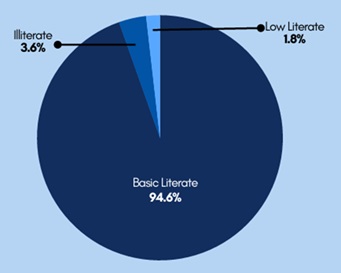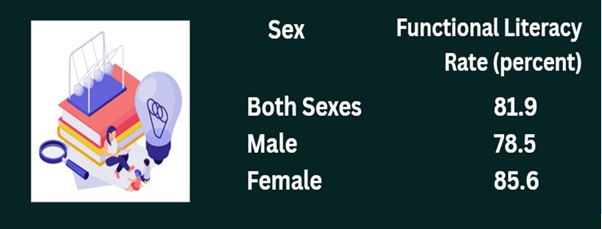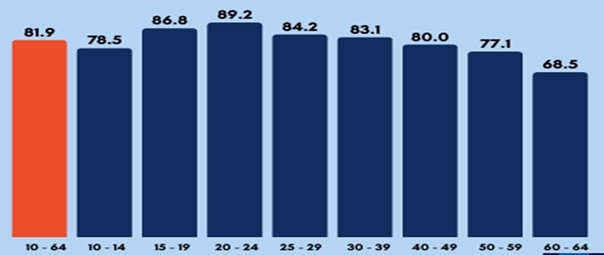9 in 10 Romblomanons are Basic Literate
Based on the 2024 Functional Literacy, Education and Mass Media Survey (2024 FLEMMS), Romblon’s basic literacy rate stands at 94.6 percent, indicating that approximately 9 out of 10 Romblomanons aged 5 years and over can read, write, and perform basic computations. When disaggregated by sex, the data show a slightly higher basic literacy rate among females at 95.0 percent compared to 94.2 percent among males, highlighting a minimal gender gap in basic literacy skills within the province.
Figure 1. Basic Literacy Rate of Household Population Five Years Old and Over by Sex: Romblon, 2024

Source: Philippine Statistics Authority, 2024 Functional Literacy, Education and Mass Media Survey
The data also reveal that 1.8 percent of the population are classified as low literate - individuals who may have limited ability to read or write simple messages or recognize letters and numbers, but do not meet the full criteria of basic literacy. Meanwhile, 3.6 percent of the population are considered illiterate, lacking the ability to read or write even simple messages in any language. These figures underscore the need for targeted literacy interventions to address the small yet significant portion of the population that remains educationally vulnerable, particularly among marginalized or hard-to-reach communities. (Figure 2)
Figure 2. Levels of Literacy for Population
5 Years Old and Over, Romblon: 2024

The 2024 FLEMMS also reveals that basic literacy in Romblon varies significantly across age groups, with younger and middle-aged generally exhibiting higher literacy rates. Among children aged 5 to 9, the basic literacy rate is 88.3 percent, reflecting ongoing early literacy development. Literacy improves sharply in the 10–14 age group, reaching 97.0 percent, and peaks among those aged 15–19 (98.5%), 20–24 (97.2%), and 25–29 (97.6%), indicating strong educational access during formative schooling years. High literacy continues through the 30–39 (97.2%) and 40–49 (96.9%) age groups, showing sustained literacy skills in adulthood. However, the rate begins to gradually decline among older age brackets, with 94.5 percent in the 50–59 group and a more noticeable drop to 85.8 percent among those aged 60 and above. This pattern suggests generational progress in literacy attainment, likely reflecting improved access to education over time and the long-term impact of national literacy programs. (Figure 3)
Figure 3. Basic Literacy Rate of Household Population 5 Years Old and Over by Age Group, Romblon: 2024

Source: Philippine Statistics Authority, 2024 Functional Literacy, Education and Mass Media Survey
8 in 10 Romblomanons are Functionally Literate
Figure 4. Functional Literacy Rate of Household Population 10 to 64 Years Old by Sex: Romblon, 2024

Source: Philippine Statistics Authority, 2024 Functional Literacy, Education and Mass Media Survey
The 2024 FLEMMS also reveal that Romblon’s functional literacy rate stands at 81.9 percent among the population aged 10 to 64 years. Functional literacy is the ability of a person to read, write, compute, and comprehend. In addition to the basic literacy skills, functional literacy includes higher level of comprehension skills, such as integrating two or more pieces of information and making inferences based on the given information. Disaggregated by sex, the data reveal a notable gender disparity: 85.6 percent of females in Romblon are functionally literate compared to 78.5 percent of males. This gap suggests that females in the province tend to achieve higher levels of applied literacy, possibly due to differences in educational attainment, school participation rates, or access to lifelong learning opportunities. The lower rate among males may point to the need for more inclusive and gender-responsive literacy programs that consider the specific barriers faced by boys and men in continuing their education or acquiring practical literacy skills. (Figure 4)
Figure 5. Functional Literacy Rate of Household Population 10 to 64 Years Old by Age Group, Romblon: 2024

Source: Philippine Statistics Authority, 2024 Functional Literacy, Education and Mass Media Survey
The 2024 FLEMMS shows that functional literacy in Romblon follows a clear pattern across age groups — it’s highest among the youth and slowly goes down as people get older. About 78.5% of those aged 10–14 are functionally literate, which improves to 86.8% for ages 15–19 and reaches the highest at 89.2% among young adults aged 20–24. This is likely because most are still in school or recently finished. After that, the numbers begin to drop: 84.2% for ages 25–29, 83.1% for 30–39, 80.0% for 40–49, and 77.1% for 50–59. The lowest is among those aged 60–64, at 68.5%. This shows that older generations may not have had the same access to education, and highlights the need to support learning even in later years. (Figure 5)
(SGD) ENGR. JOHNNY F. SOLIS
Chief Statistical Specialist
Romblon Provincial Statistical Office

